HND Health and Social Care Management: Change Facilitation Report
VerifiedAdded on 2023/01/09
|15
|5715
|35
Report
AI Summary
This report, focusing on Unit 26 of the HND Health and Social Care Management curriculum, explores the multifaceted aspects of facilitating change within health and social care settings. It begins by explaining the key internal and external factors that drive change, such as economic conditions, new management, technological advancements, competition, political factors, and outbreaks, using the Beacon Edge Care Home as a case study. The report then assesses the challenges these factors bring, including staff resistance, middle management resistance, lack of training, resource limitations, and time constraints. Furthermore, it outlines strategies and criteria for measuring recent changes, emphasizing staff and service user satisfaction, and discusses methods such as interviews and questionnaires. The report also measures the impact of changes against set criteria, proposing appropriate service responses. Finally, it explains key change management principles, planning processes, and monitoring techniques, providing a comprehensive overview of change management in health and social care.
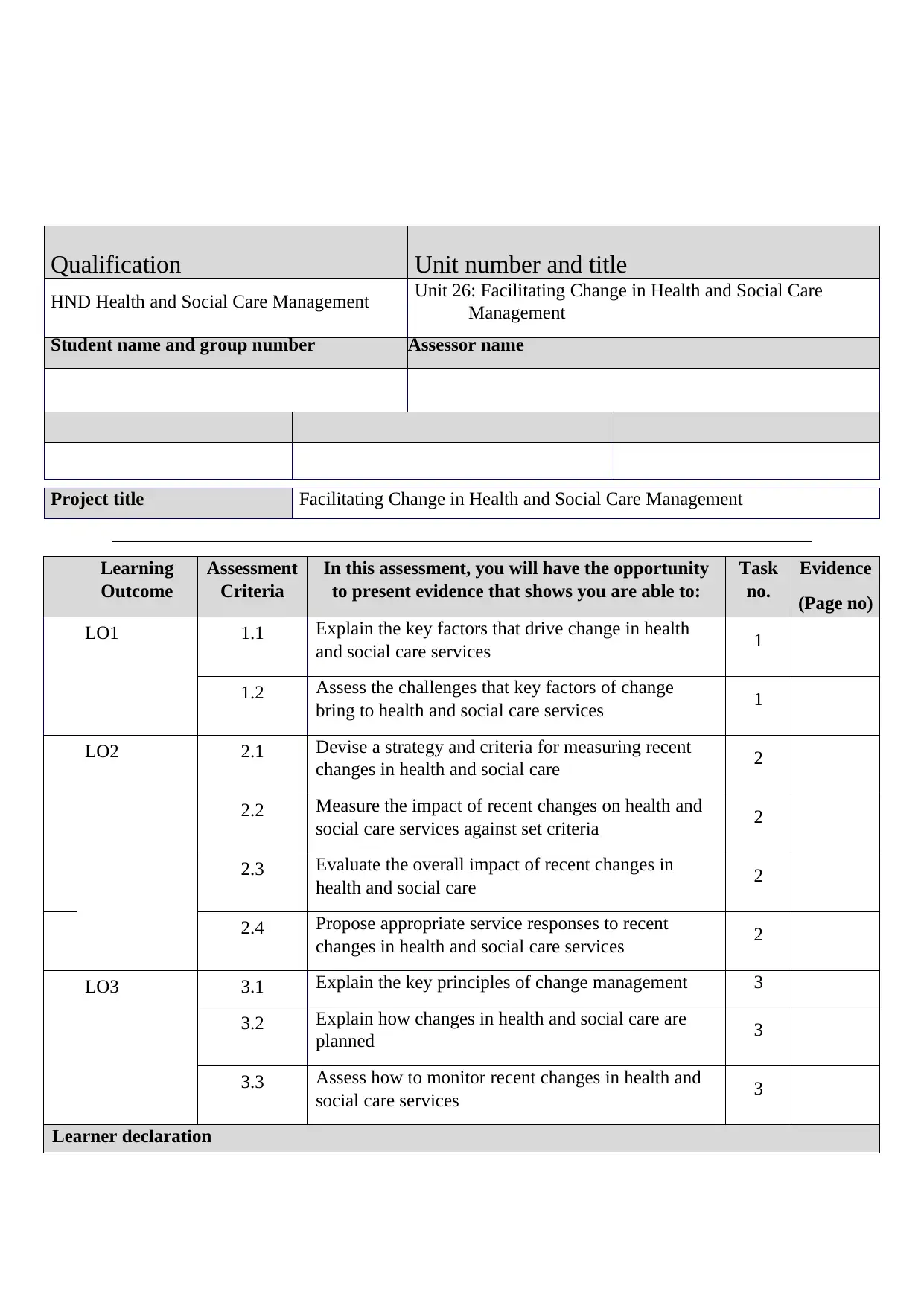
Qualification Unit number and title
HND Health and Social Care Management Unit 26: Facilitating Change in Health and Social Care
Management
Student name and group number Assessor name
Project title Facilitating Change in Health and Social Care Management
Learning
Outcome
Assessment
Criteria
In this assessment, you will have the opportunity
to present evidence that shows you are able to:
Task
no.
Evidence
(Page no)
LO1 1.1 Explain the key factors that drive change in health
and social care services 1
1.2 Assess the challenges that key factors of change
bring to health and social care services 1
LO2 2.1 Devise a strategy and criteria for measuring recent
changes in health and social care 2
2.2 Measure the impact of recent changes on health and
social care services against set criteria 2
2.3 Evaluate the overall impact of recent changes in
health and social care 2
2.4 Propose appropriate service responses to recent
changes in health and social care services 2
LO3 3.1 Explain the key principles of change management 3
3.2 Explain how changes in health and social care are
planned 3
3.3 Assess how to monitor recent changes in health and
social care services 3
Learner declaration
HND Health and Social Care Management Unit 26: Facilitating Change in Health and Social Care
Management
Student name and group number Assessor name
Project title Facilitating Change in Health and Social Care Management
Learning
Outcome
Assessment
Criteria
In this assessment, you will have the opportunity
to present evidence that shows you are able to:
Task
no.
Evidence
(Page no)
LO1 1.1 Explain the key factors that drive change in health
and social care services 1
1.2 Assess the challenges that key factors of change
bring to health and social care services 1
LO2 2.1 Devise a strategy and criteria for measuring recent
changes in health and social care 2
2.2 Measure the impact of recent changes on health and
social care services against set criteria 2
2.3 Evaluate the overall impact of recent changes in
health and social care 2
2.4 Propose appropriate service responses to recent
changes in health and social care services 2
LO3 3.1 Explain the key principles of change management 3
3.2 Explain how changes in health and social care are
planned 3
3.3 Assess how to monitor recent changes in health and
social care services 3
Learner declaration
Paraphrase This Document
Need a fresh take? Get an instant paraphrase of this document with our AI Paraphraser
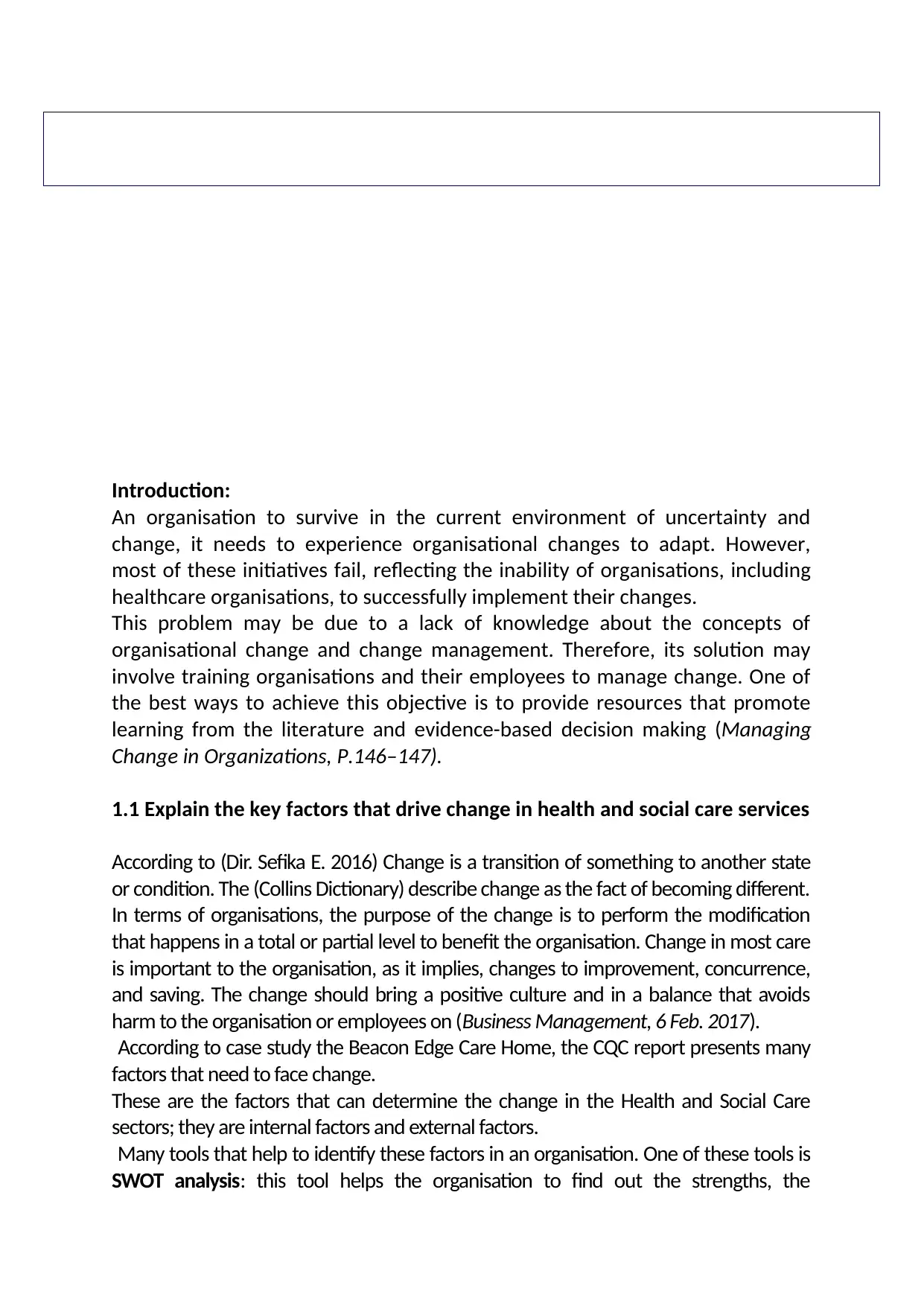
Introduction:
An organisation to survive in the current environment of uncertainty and
change, it needs to experience organisational changes to adapt. However,
most of these initiatives fail, reflecting the inability of organisations, including
healthcare organisations, to successfully implement their changes.
This problem may be due to a lack of knowledge about the concepts of
organisational change and change management. Therefore, its solution may
involve training organisations and their employees to manage change. One of
the best ways to achieve this objective is to provide resources that promote
learning from the literature and evidence-based decision making (Managing
Change in Organizations, P.146–147).
1.1 Explain the key factors that drive change in health and social care services
According to (Dir. Sefika E. 2016) Change is a transition of something to another state
or condition. The (Collins Dictionary) describe change as the fact of becoming different.
In terms of organisations, the purpose of the change is to perform the modification
that happens in a total or partial level to benefit the organisation. Change in most care
is important to the organisation, as it implies, changes to improvement, concurrence,
and saving. The change should bring a positive culture and in a balance that avoids
harm to the organisation or employees on (Business Management, 6 Feb. 2017).
According to case study the Beacon Edge Care Home, the CQC report presents many
factors that need to face change.
These are the factors that can determine the change in the Health and Social Care
sectors; they are internal factors and external factors.
Many tools that help to identify these factors in an organisation. One of these tools is
SWOT analysis: this tool helps the organisation to find out the strengths, the
An organisation to survive in the current environment of uncertainty and
change, it needs to experience organisational changes to adapt. However,
most of these initiatives fail, reflecting the inability of organisations, including
healthcare organisations, to successfully implement their changes.
This problem may be due to a lack of knowledge about the concepts of
organisational change and change management. Therefore, its solution may
involve training organisations and their employees to manage change. One of
the best ways to achieve this objective is to provide resources that promote
learning from the literature and evidence-based decision making (Managing
Change in Organizations, P.146–147).
1.1 Explain the key factors that drive change in health and social care services
According to (Dir. Sefika E. 2016) Change is a transition of something to another state
or condition. The (Collins Dictionary) describe change as the fact of becoming different.
In terms of organisations, the purpose of the change is to perform the modification
that happens in a total or partial level to benefit the organisation. Change in most care
is important to the organisation, as it implies, changes to improvement, concurrence,
and saving. The change should bring a positive culture and in a balance that avoids
harm to the organisation or employees on (Business Management, 6 Feb. 2017).
According to case study the Beacon Edge Care Home, the CQC report presents many
factors that need to face change.
These are the factors that can determine the change in the Health and Social Care
sectors; they are internal factors and external factors.
Many tools that help to identify these factors in an organisation. One of these tools is
SWOT analysis: this tool helps the organisation to find out the strengths, the
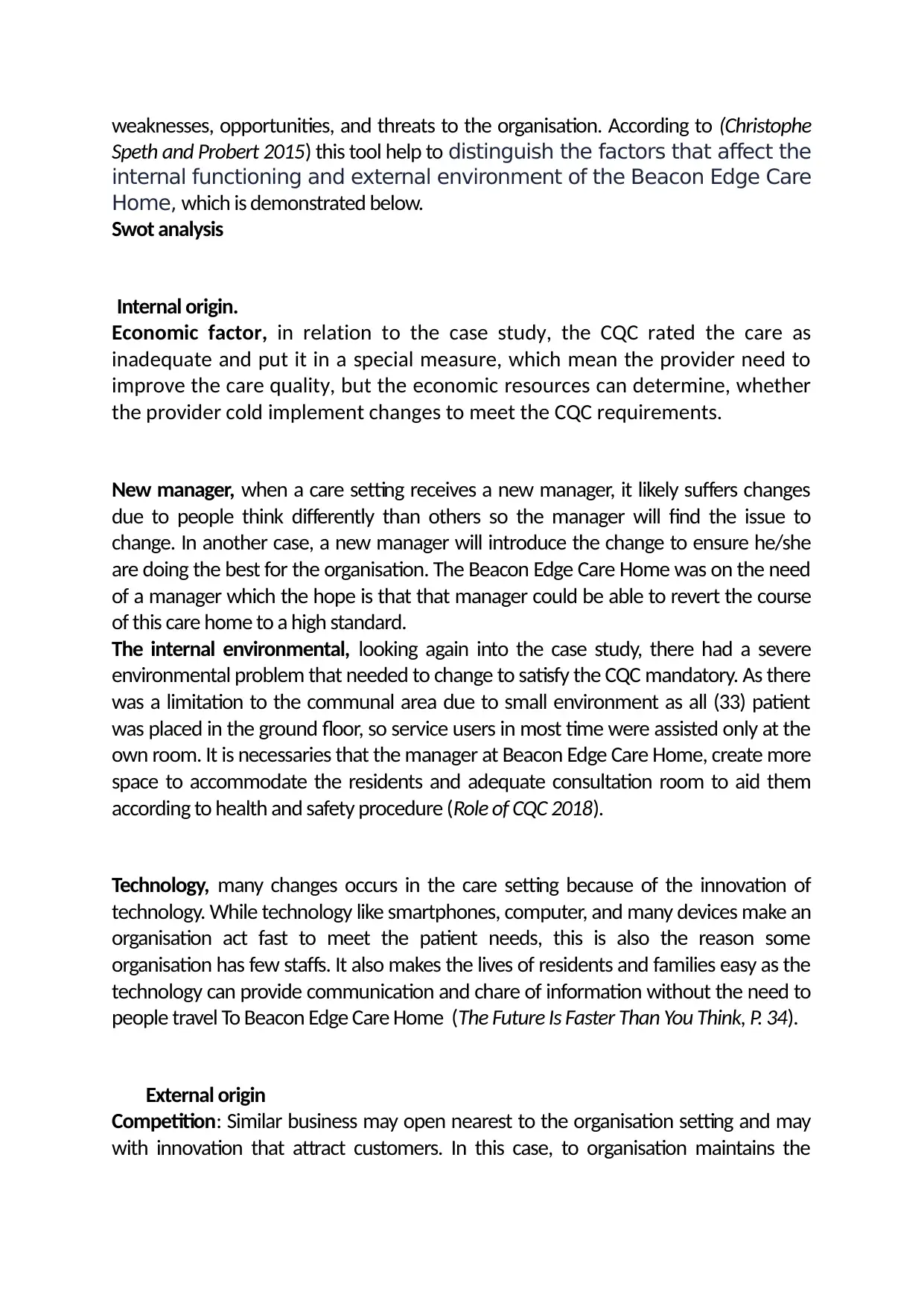
weaknesses, opportunities, and threats to the organisation. According to (Christophe
Speth and Probert 2015) this tool help to distinguish the factors that affect the
internal functioning and external environment of the Beacon Edge Care
Home, which is demonstrated below.
Swot analysis
Internal origin.
Economic factor, in relation to the case study, the CQC rated the care as
inadequate and put it in a special measure, which mean the provider need to
improve the care quality, but the economic resources can determine, whether
the provider cold implement changes to meet the CQC requirements.
New manager, when a care setting receives a new manager, it likely suffers changes
due to people think differently than others so the manager will find the issue to
change. In another case, a new manager will introduce the change to ensure he/she
are doing the best for the organisation. The Beacon Edge Care Home was on the need
of a manager which the hope is that that manager could be able to revert the course
of this care home to a high standard.
The internal environmental, looking again into the case study, there had a severe
environmental problem that needed to change to satisfy the CQC mandatory. As there
was a limitation to the communal area due to small environment as all (33) patient
was placed in the ground floor, so service users in most time were assisted only at the
own room. It is necessaries that the manager at Beacon Edge Care Home, create more
space to accommodate the residents and adequate consultation room to aid them
according to health and safety procedure (Role of CQC 2018).
Technology, many changes occurs in the care setting because of the innovation of
technology. While technology like smartphones, computer, and many devices make an
organisation act fast to meet the patient needs, this is also the reason some
organisation has few staffs. It also makes the lives of residents and families easy as the
technology can provide communication and chare of information without the need to
people travel To Beacon Edge Care Home (The Future Is Faster Than You Think, P. 34).
External origin
Competition: Similar business may open nearest to the organisation setting and may
with innovation that attract customers. In this case, to organisation maintains the
Speth and Probert 2015) this tool help to distinguish the factors that affect the
internal functioning and external environment of the Beacon Edge Care
Home, which is demonstrated below.
Swot analysis
Internal origin.
Economic factor, in relation to the case study, the CQC rated the care as
inadequate and put it in a special measure, which mean the provider need to
improve the care quality, but the economic resources can determine, whether
the provider cold implement changes to meet the CQC requirements.
New manager, when a care setting receives a new manager, it likely suffers changes
due to people think differently than others so the manager will find the issue to
change. In another case, a new manager will introduce the change to ensure he/she
are doing the best for the organisation. The Beacon Edge Care Home was on the need
of a manager which the hope is that that manager could be able to revert the course
of this care home to a high standard.
The internal environmental, looking again into the case study, there had a severe
environmental problem that needed to change to satisfy the CQC mandatory. As there
was a limitation to the communal area due to small environment as all (33) patient
was placed in the ground floor, so service users in most time were assisted only at the
own room. It is necessaries that the manager at Beacon Edge Care Home, create more
space to accommodate the residents and adequate consultation room to aid them
according to health and safety procedure (Role of CQC 2018).
Technology, many changes occurs in the care setting because of the innovation of
technology. While technology like smartphones, computer, and many devices make an
organisation act fast to meet the patient needs, this is also the reason some
organisation has few staffs. It also makes the lives of residents and families easy as the
technology can provide communication and chare of information without the need to
people travel To Beacon Edge Care Home (The Future Is Faster Than You Think, P. 34).
External origin
Competition: Similar business may open nearest to the organisation setting and may
with innovation that attract customers. In this case, to organisation maintains the
⊘ This is a preview!⊘
Do you want full access?
Subscribe today to unlock all pages.

Trusted by 1+ million students worldwide
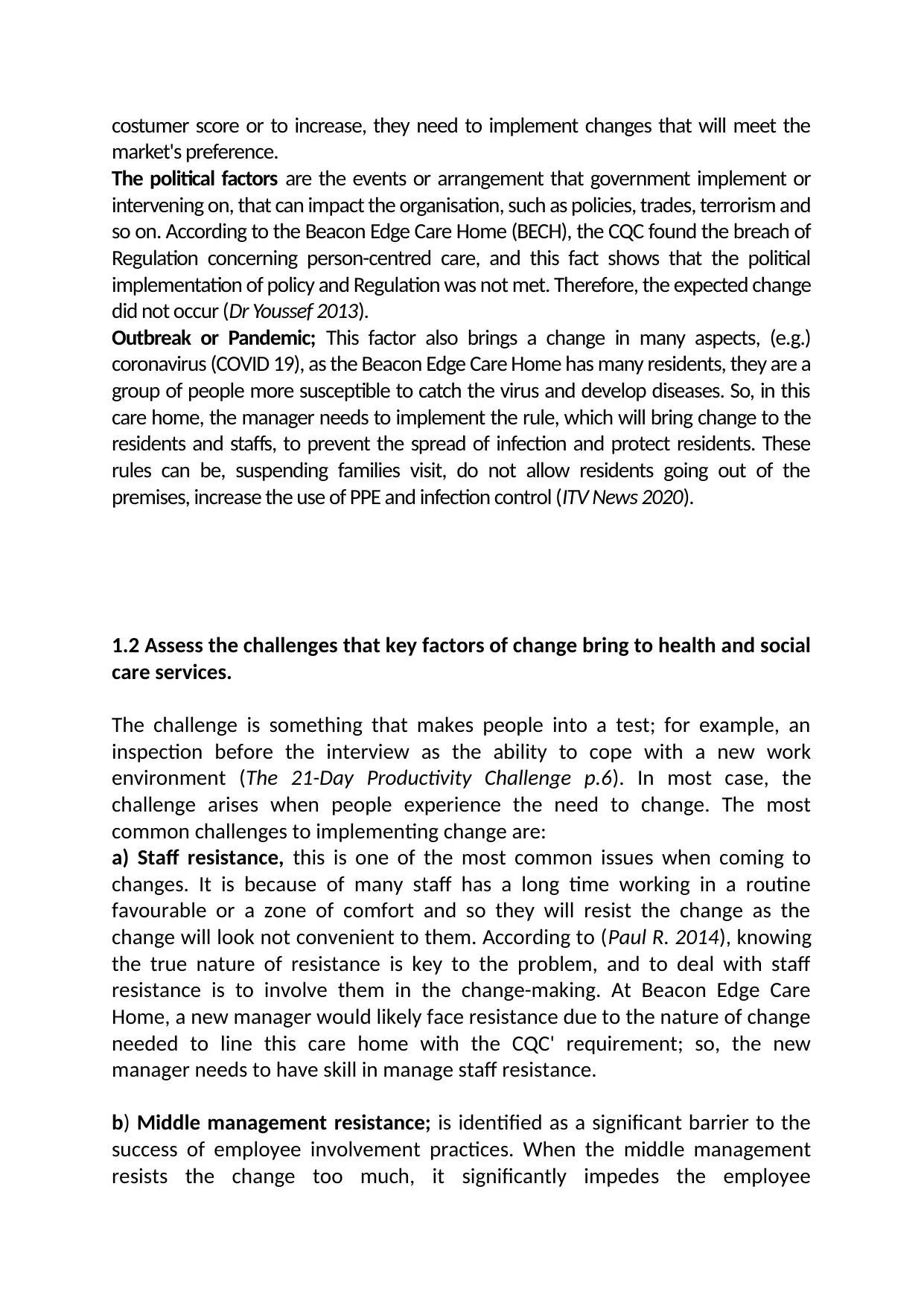
costumer score or to increase, they need to implement changes that will meet the
market's preference.
The political factors are the events or arrangement that government implement or
intervening on, that can impact the organisation, such as policies, trades, terrorism and
so on. According to the Beacon Edge Care Home (BECH), the CQC found the breach of
Regulation concerning person-centred care, and this fact shows that the political
implementation of policy and Regulation was not met. Therefore, the expected change
did not occur (Dr Youssef 2013).
Outbreak or Pandemic; This factor also brings a change in many aspects, (e.g.)
coronavirus (COVID 19), as the Beacon Edge Care Home has many residents, they are a
group of people more susceptible to catch the virus and develop diseases. So, in this
care home, the manager needs to implement the rule, which will bring change to the
residents and staffs, to prevent the spread of infection and protect residents. These
rules can be, suspending families visit, do not allow residents going out of the
premises, increase the use of PPE and infection control (ITV News 2020).
1.2 Assess the challenges that key factors of change bring to health and social
care services.
The challenge is something that makes people into a test; for example, an
inspection before the interview as the ability to cope with a new work
environment (The 21-Day Productivity Challenge p.6). In most case, the
challenge arises when people experience the need to change. The most
common challenges to implementing change are:
a) Staff resistance, this is one of the most common issues when coming to
changes. It is because of many staff has a long time working in a routine
favourable or a zone of comfort and so they will resist the change as the
change will look not convenient to them. According to (Paul R. 2014), knowing
the true nature of resistance is key to the problem, and to deal with staff
resistance is to involve them in the change-making. At Beacon Edge Care
Home, a new manager would likely face resistance due to the nature of change
needed to line this care home with the CQC' requirement; so, the new
manager needs to have skill in manage staff resistance.
b) Middle management resistance; is identified as a significant barrier to the
success of employee involvement practices. When the middle management
resists the change too much, it significantly impedes the employee
market's preference.
The political factors are the events or arrangement that government implement or
intervening on, that can impact the organisation, such as policies, trades, terrorism and
so on. According to the Beacon Edge Care Home (BECH), the CQC found the breach of
Regulation concerning person-centred care, and this fact shows that the political
implementation of policy and Regulation was not met. Therefore, the expected change
did not occur (Dr Youssef 2013).
Outbreak or Pandemic; This factor also brings a change in many aspects, (e.g.)
coronavirus (COVID 19), as the Beacon Edge Care Home has many residents, they are a
group of people more susceptible to catch the virus and develop diseases. So, in this
care home, the manager needs to implement the rule, which will bring change to the
residents and staffs, to prevent the spread of infection and protect residents. These
rules can be, suspending families visit, do not allow residents going out of the
premises, increase the use of PPE and infection control (ITV News 2020).
1.2 Assess the challenges that key factors of change bring to health and social
care services.
The challenge is something that makes people into a test; for example, an
inspection before the interview as the ability to cope with a new work
environment (The 21-Day Productivity Challenge p.6). In most case, the
challenge arises when people experience the need to change. The most
common challenges to implementing change are:
a) Staff resistance, this is one of the most common issues when coming to
changes. It is because of many staff has a long time working in a routine
favourable or a zone of comfort and so they will resist the change as the
change will look not convenient to them. According to (Paul R. 2014), knowing
the true nature of resistance is key to the problem, and to deal with staff
resistance is to involve them in the change-making. At Beacon Edge Care
Home, a new manager would likely face resistance due to the nature of change
needed to line this care home with the CQC' requirement; so, the new
manager needs to have skill in manage staff resistance.
b) Middle management resistance; is identified as a significant barrier to the
success of employee involvement practices. When the middle management
resists the change too much, it significantly impedes the employee
Paraphrase This Document
Need a fresh take? Get an instant paraphrase of this document with our AI Paraphraser
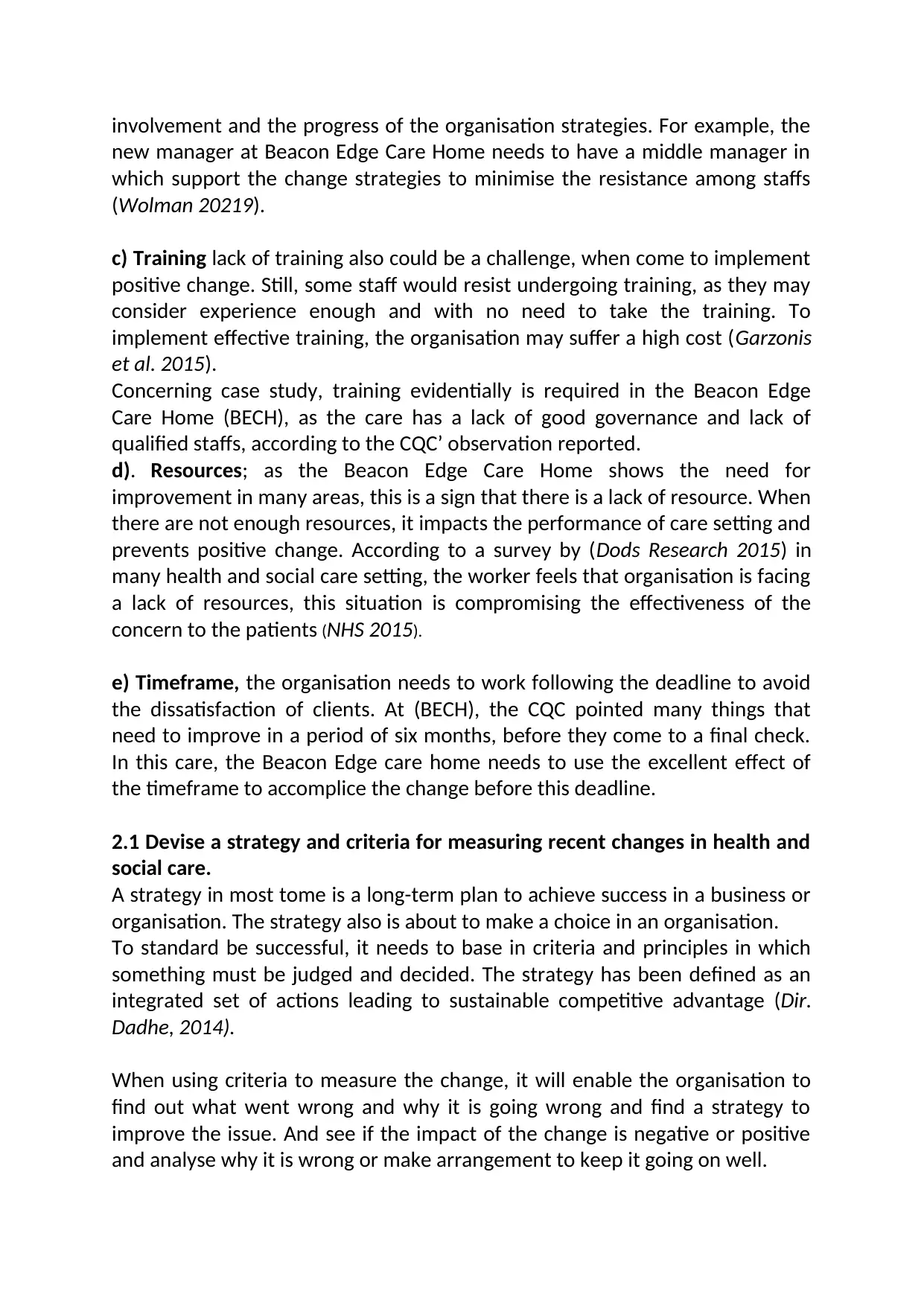
involvement and the progress of the organisation strategies. For example, the
new manager at Beacon Edge Care Home needs to have a middle manager in
which support the change strategies to minimise the resistance among staffs
(Wolman 20219).
c) Training lack of training also could be a challenge, when come to implement
positive change. Still, some staff would resist undergoing training, as they may
consider experience enough and with no need to take the training. To
implement effective training, the organisation may suffer a high cost (Garzonis
et al. 2015).
Concerning case study, training evidentially is required in the Beacon Edge
Care Home (BECH), as the care has a lack of good governance and lack of
qualified staffs, according to the CQC’ observation reported.
d). Resources; as the Beacon Edge Care Home shows the need for
improvement in many areas, this is a sign that there is a lack of resource. When
there are not enough resources, it impacts the performance of care setting and
prevents positive change. According to a survey by (Dods Research 2015) in
many health and social care setting, the worker feels that organisation is facing
a lack of resources, this situation is compromising the effectiveness of the
concern to the patients (NHS 2015).
e) Timeframe, the organisation needs to work following the deadline to avoid
the dissatisfaction of clients. At (BECH), the CQC pointed many things that
need to improve in a period of six months, before they come to a final check.
In this care, the Beacon Edge care home needs to use the excellent effect of
the timeframe to accomplice the change before this deadline.
2.1 Devise a strategy and criteria for measuring recent changes in health and
social care.
A strategy in most tome is a long-term plan to achieve success in a business or
organisation. The strategy also is about to make a choice in an organisation.
To standard be successful, it needs to base in criteria and principles in which
something must be judged and decided. The strategy has been defined as an
integrated set of actions leading to sustainable competitive advantage (Dir.
Dadhe, 2014).
When using criteria to measure the change, it will enable the organisation to
find out what went wrong and why it is going wrong and find a strategy to
improve the issue. And see if the impact of the change is negative or positive
and analyse why it is wrong or make arrangement to keep it going on well.
new manager at Beacon Edge Care Home needs to have a middle manager in
which support the change strategies to minimise the resistance among staffs
(Wolman 20219).
c) Training lack of training also could be a challenge, when come to implement
positive change. Still, some staff would resist undergoing training, as they may
consider experience enough and with no need to take the training. To
implement effective training, the organisation may suffer a high cost (Garzonis
et al. 2015).
Concerning case study, training evidentially is required in the Beacon Edge
Care Home (BECH), as the care has a lack of good governance and lack of
qualified staffs, according to the CQC’ observation reported.
d). Resources; as the Beacon Edge Care Home shows the need for
improvement in many areas, this is a sign that there is a lack of resource. When
there are not enough resources, it impacts the performance of care setting and
prevents positive change. According to a survey by (Dods Research 2015) in
many health and social care setting, the worker feels that organisation is facing
a lack of resources, this situation is compromising the effectiveness of the
concern to the patients (NHS 2015).
e) Timeframe, the organisation needs to work following the deadline to avoid
the dissatisfaction of clients. At (BECH), the CQC pointed many things that
need to improve in a period of six months, before they come to a final check.
In this care, the Beacon Edge care home needs to use the excellent effect of
the timeframe to accomplice the change before this deadline.
2.1 Devise a strategy and criteria for measuring recent changes in health and
social care.
A strategy in most tome is a long-term plan to achieve success in a business or
organisation. The strategy also is about to make a choice in an organisation.
To standard be successful, it needs to base in criteria and principles in which
something must be judged and decided. The strategy has been defined as an
integrated set of actions leading to sustainable competitive advantage (Dir.
Dadhe, 2014).
When using criteria to measure the change, it will enable the organisation to
find out what went wrong and why it is going wrong and find a strategy to
improve the issue. And see if the impact of the change is negative or positive
and analyse why it is wrong or make arrangement to keep it going on well.
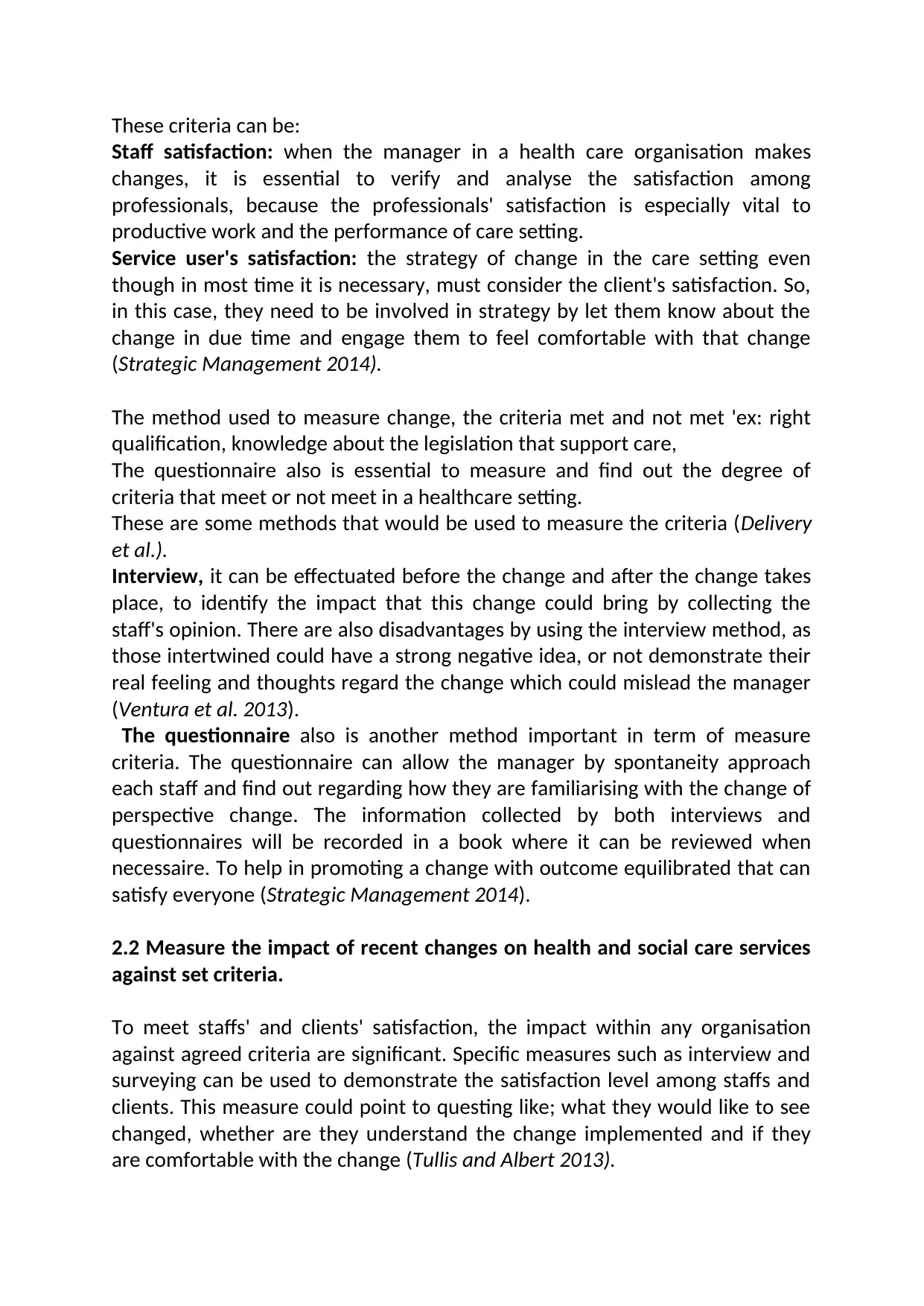
These criteria can be:
Staff satisfaction: when the manager in a health care organisation makes
changes, it is essential to verify and analyse the satisfaction among
professionals, because the professionals' satisfaction is especially vital to
productive work and the performance of care setting.
Service user's satisfaction: the strategy of change in the care setting even
though in most time it is necessary, must consider the client's satisfaction. So,
in this case, they need to be involved in strategy by let them know about the
change in due time and engage them to feel comfortable with that change
(Strategic Management 2014).
The method used to measure change, the criteria met and not met 'ex: right
qualification, knowledge about the legislation that support care,
The questionnaire also is essential to measure and find out the degree of
criteria that meet or not meet in a healthcare setting.
These are some methods that would be used to measure the criteria (Delivery
et al.).
Interview, it can be effectuated before the change and after the change takes
place, to identify the impact that this change could bring by collecting the
staff's opinion. There are also disadvantages by using the interview method, as
those intertwined could have a strong negative idea, or not demonstrate their
real feeling and thoughts regard the change which could mislead the manager
(Ventura et al. 2013).
The questionnaire also is another method important in term of measure
criteria. The questionnaire can allow the manager by spontaneity approach
each staff and find out regarding how they are familiarising with the change of
perspective change. The information collected by both interviews and
questionnaires will be recorded in a book where it can be reviewed when
necessaire. To help in promoting a change with outcome equilibrated that can
satisfy everyone (Strategic Management 2014).
2.2 Measure the impact of recent changes on health and social care services
against set criteria.
To meet staffs' and clients' satisfaction, the impact within any organisation
against agreed criteria are significant. Specific measures such as interview and
surveying can be used to demonstrate the satisfaction level among staffs and
clients. This measure could point to questing like; what they would like to see
changed, whether are they understand the change implemented and if they
are comfortable with the change (Tullis and Albert 2013).
Staff satisfaction: when the manager in a health care organisation makes
changes, it is essential to verify and analyse the satisfaction among
professionals, because the professionals' satisfaction is especially vital to
productive work and the performance of care setting.
Service user's satisfaction: the strategy of change in the care setting even
though in most time it is necessary, must consider the client's satisfaction. So,
in this case, they need to be involved in strategy by let them know about the
change in due time and engage them to feel comfortable with that change
(Strategic Management 2014).
The method used to measure change, the criteria met and not met 'ex: right
qualification, knowledge about the legislation that support care,
The questionnaire also is essential to measure and find out the degree of
criteria that meet or not meet in a healthcare setting.
These are some methods that would be used to measure the criteria (Delivery
et al.).
Interview, it can be effectuated before the change and after the change takes
place, to identify the impact that this change could bring by collecting the
staff's opinion. There are also disadvantages by using the interview method, as
those intertwined could have a strong negative idea, or not demonstrate their
real feeling and thoughts regard the change which could mislead the manager
(Ventura et al. 2013).
The questionnaire also is another method important in term of measure
criteria. The questionnaire can allow the manager by spontaneity approach
each staff and find out regarding how they are familiarising with the change of
perspective change. The information collected by both interviews and
questionnaires will be recorded in a book where it can be reviewed when
necessaire. To help in promoting a change with outcome equilibrated that can
satisfy everyone (Strategic Management 2014).
2.2 Measure the impact of recent changes on health and social care services
against set criteria.
To meet staffs' and clients' satisfaction, the impact within any organisation
against agreed criteria are significant. Specific measures such as interview and
surveying can be used to demonstrate the satisfaction level among staffs and
clients. This measure could point to questing like; what they would like to see
changed, whether are they understand the change implemented and if they
are comfortable with the change (Tullis and Albert 2013).
⊘ This is a preview!⊘
Do you want full access?
Subscribe today to unlock all pages.

Trusted by 1+ million students worldwide
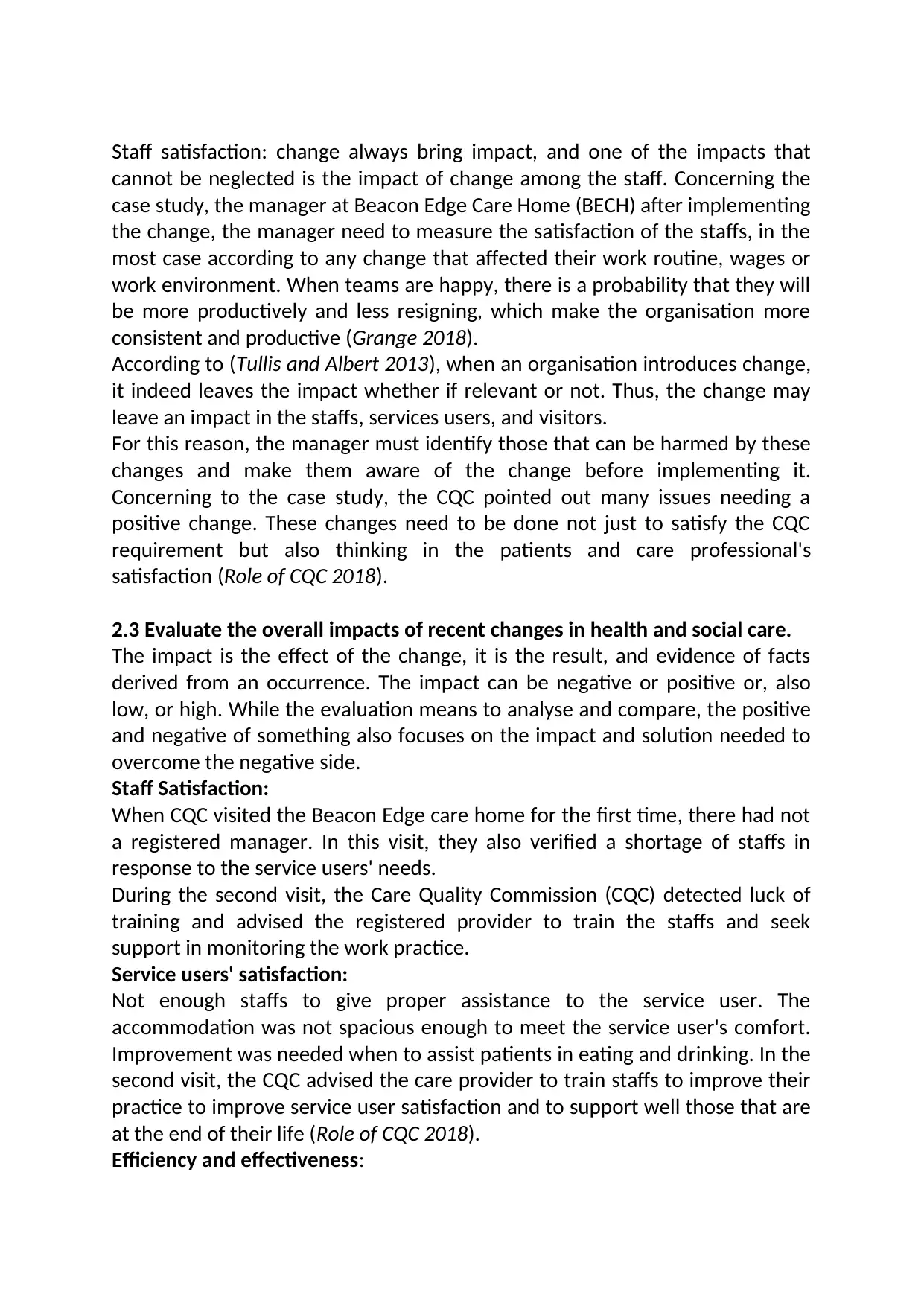
Staff satisfaction: change always bring impact, and one of the impacts that
cannot be neglected is the impact of change among the staff. Concerning the
case study, the manager at Beacon Edge Care Home (BECH) after implementing
the change, the manager need to measure the satisfaction of the staffs, in the
most case according to any change that affected their work routine, wages or
work environment. When teams are happy, there is a probability that they will
be more productively and less resigning, which make the organisation more
consistent and productive (Grange 2018).
According to (Tullis and Albert 2013), when an organisation introduces change,
it indeed leaves the impact whether if relevant or not. Thus, the change may
leave an impact in the staffs, services users, and visitors.
For this reason, the manager must identify those that can be harmed by these
changes and make them aware of the change before implementing it.
Concerning to the case study, the CQC pointed out many issues needing a
positive change. These changes need to be done not just to satisfy the CQC
requirement but also thinking in the patients and care professional's
satisfaction (Role of CQC 2018).
2.3 Evaluate the overall impacts of recent changes in health and social care.
The impact is the effect of the change, it is the result, and evidence of facts
derived from an occurrence. The impact can be negative or positive or, also
low, or high. While the evaluation means to analyse and compare, the positive
and negative of something also focuses on the impact and solution needed to
overcome the negative side.
Staff Satisfaction:
When CQC visited the Beacon Edge care home for the first time, there had not
a registered manager. In this visit, they also verified a shortage of staffs in
response to the service users' needs.
During the second visit, the Care Quality Commission (CQC) detected luck of
training and advised the registered provider to train the staffs and seek
support in monitoring the work practice.
Service users' satisfaction:
Not enough staffs to give proper assistance to the service user. The
accommodation was not spacious enough to meet the service user's comfort.
Improvement was needed when to assist patients in eating and drinking. In the
second visit, the CQC advised the care provider to train staffs to improve their
practice to improve service user satisfaction and to support well those that are
at the end of their life (Role of CQC 2018).
Efficiency and effectiveness:
cannot be neglected is the impact of change among the staff. Concerning the
case study, the manager at Beacon Edge Care Home (BECH) after implementing
the change, the manager need to measure the satisfaction of the staffs, in the
most case according to any change that affected their work routine, wages or
work environment. When teams are happy, there is a probability that they will
be more productively and less resigning, which make the organisation more
consistent and productive (Grange 2018).
According to (Tullis and Albert 2013), when an organisation introduces change,
it indeed leaves the impact whether if relevant or not. Thus, the change may
leave an impact in the staffs, services users, and visitors.
For this reason, the manager must identify those that can be harmed by these
changes and make them aware of the change before implementing it.
Concerning to the case study, the CQC pointed out many issues needing a
positive change. These changes need to be done not just to satisfy the CQC
requirement but also thinking in the patients and care professional's
satisfaction (Role of CQC 2018).
2.3 Evaluate the overall impacts of recent changes in health and social care.
The impact is the effect of the change, it is the result, and evidence of facts
derived from an occurrence. The impact can be negative or positive or, also
low, or high. While the evaluation means to analyse and compare, the positive
and negative of something also focuses on the impact and solution needed to
overcome the negative side.
Staff Satisfaction:
When CQC visited the Beacon Edge care home for the first time, there had not
a registered manager. In this visit, they also verified a shortage of staffs in
response to the service users' needs.
During the second visit, the Care Quality Commission (CQC) detected luck of
training and advised the registered provider to train the staffs and seek
support in monitoring the work practice.
Service users' satisfaction:
Not enough staffs to give proper assistance to the service user. The
accommodation was not spacious enough to meet the service user's comfort.
Improvement was needed when to assist patients in eating and drinking. In the
second visit, the CQC advised the care provider to train staffs to improve their
practice to improve service user satisfaction and to support well those that are
at the end of their life (Role of CQC 2018).
Efficiency and effectiveness:
Paraphrase This Document
Need a fresh take? Get an instant paraphrase of this document with our AI Paraphraser
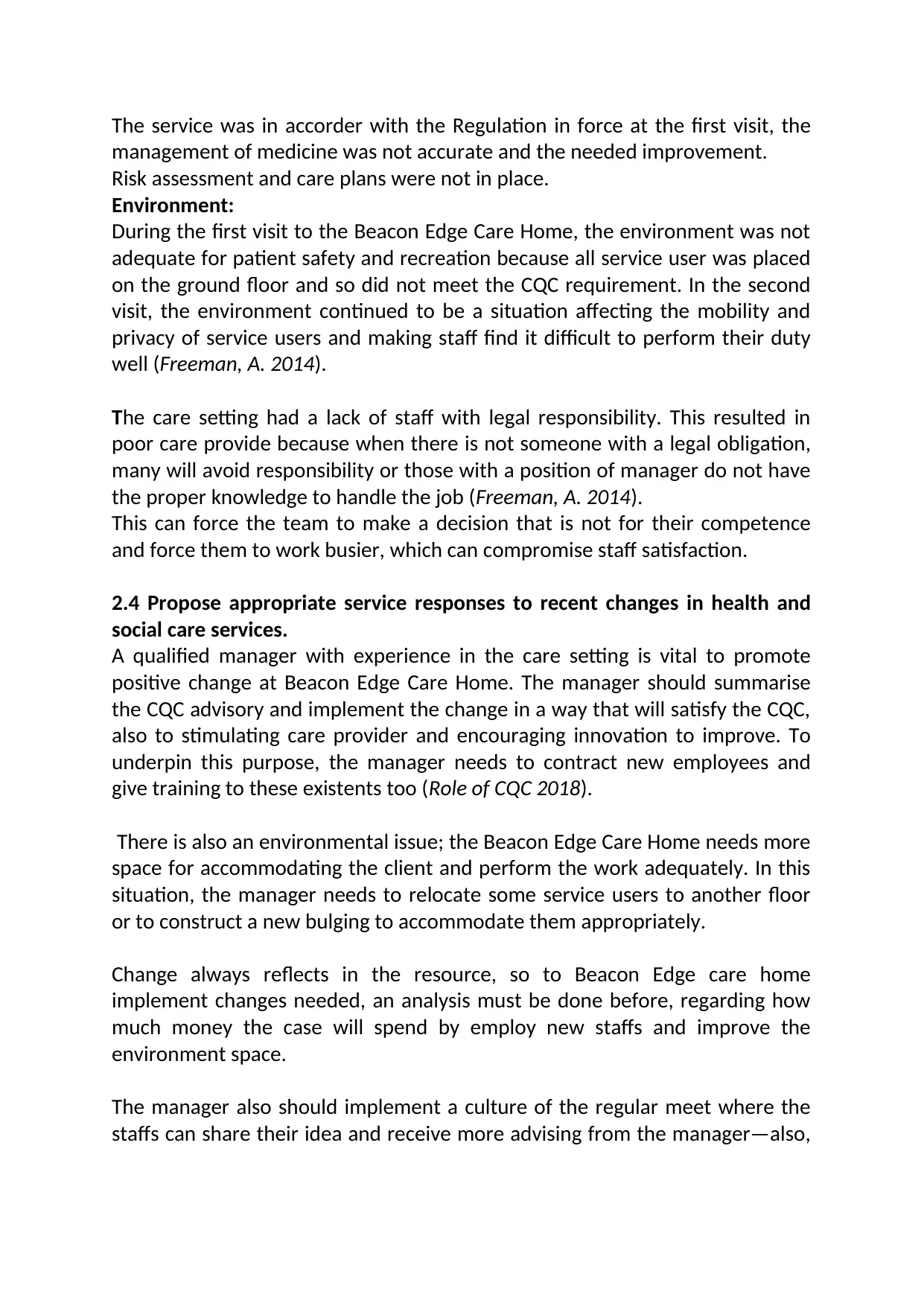
The service was in accorder with the Regulation in force at the first visit, the
management of medicine was not accurate and the needed improvement.
Risk assessment and care plans were not in place.
Environment:
During the first visit to the Beacon Edge Care Home, the environment was not
adequate for patient safety and recreation because all service user was placed
on the ground floor and so did not meet the CQC requirement. In the second
visit, the environment continued to be a situation affecting the mobility and
privacy of service users and making staff find it difficult to perform their duty
well (Freeman, A. 2014).
The care setting had a lack of staff with legal responsibility. This resulted in
poor care provide because when there is not someone with a legal obligation,
many will avoid responsibility or those with a position of manager do not have
the proper knowledge to handle the job (Freeman, A. 2014).
This can force the team to make a decision that is not for their competence
and force them to work busier, which can compromise staff satisfaction.
2.4 Propose appropriate service responses to recent changes in health and
social care services.
A qualified manager with experience in the care setting is vital to promote
positive change at Beacon Edge Care Home. The manager should summarise
the CQC advisory and implement the change in a way that will satisfy the CQC,
also to stimulating care provider and encouraging innovation to improve. To
underpin this purpose, the manager needs to contract new employees and
give training to these existents too (Role of CQC 2018).
There is also an environmental issue; the Beacon Edge Care Home needs more
space for accommodating the client and perform the work adequately. In this
situation, the manager needs to relocate some service users to another floor
or to construct a new bulging to accommodate them appropriately.
Change always reflects in the resource, so to Beacon Edge care home
implement changes needed, an analysis must be done before, regarding how
much money the case will spend by employ new staffs and improve the
environment space.
The manager also should implement a culture of the regular meet where the
staffs can share their idea and receive more advising from the manager—also,
management of medicine was not accurate and the needed improvement.
Risk assessment and care plans were not in place.
Environment:
During the first visit to the Beacon Edge Care Home, the environment was not
adequate for patient safety and recreation because all service user was placed
on the ground floor and so did not meet the CQC requirement. In the second
visit, the environment continued to be a situation affecting the mobility and
privacy of service users and making staff find it difficult to perform their duty
well (Freeman, A. 2014).
The care setting had a lack of staff with legal responsibility. This resulted in
poor care provide because when there is not someone with a legal obligation,
many will avoid responsibility or those with a position of manager do not have
the proper knowledge to handle the job (Freeman, A. 2014).
This can force the team to make a decision that is not for their competence
and force them to work busier, which can compromise staff satisfaction.
2.4 Propose appropriate service responses to recent changes in health and
social care services.
A qualified manager with experience in the care setting is vital to promote
positive change at Beacon Edge Care Home. The manager should summarise
the CQC advisory and implement the change in a way that will satisfy the CQC,
also to stimulating care provider and encouraging innovation to improve. To
underpin this purpose, the manager needs to contract new employees and
give training to these existents too (Role of CQC 2018).
There is also an environmental issue; the Beacon Edge Care Home needs more
space for accommodating the client and perform the work adequately. In this
situation, the manager needs to relocate some service users to another floor
or to construct a new bulging to accommodate them appropriately.
Change always reflects in the resource, so to Beacon Edge care home
implement changes needed, an analysis must be done before, regarding how
much money the case will spend by employ new staffs and improve the
environment space.
The manager also should implement a culture of the regular meet where the
staffs can share their idea and receive more advising from the manager—also,
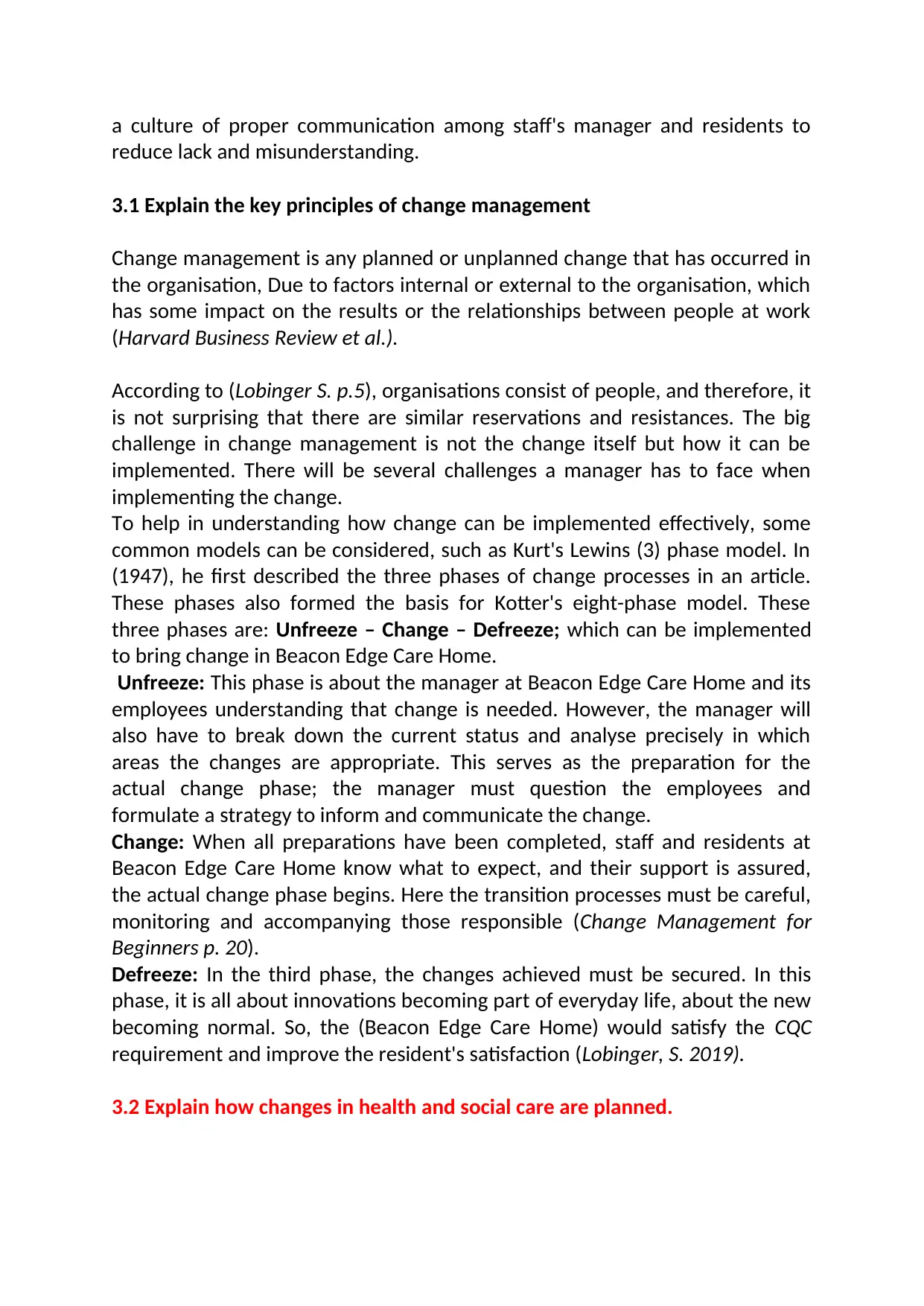
a culture of proper communication among staff's manager and residents to
reduce lack and misunderstanding.
3.1 Explain the key principles of change management
Change management is any planned or unplanned change that has occurred in
the organisation, Due to factors internal or external to the organisation, which
has some impact on the results or the relationships between people at work
(Harvard Business Review et al.).
According to (Lobinger S. p.5), organisations consist of people, and therefore, it
is not surprising that there are similar reservations and resistances. The big
challenge in change management is not the change itself but how it can be
implemented. There will be several challenges a manager has to face when
implementing the change.
To help in understanding how change can be implemented effectively, some
common models can be considered, such as Kurt's Lewins (3) phase model. In
(1947), he first described the three phases of change processes in an article.
These phases also formed the basis for Kotter's eight-phase model. These
three phases are: Unfreeze – Change – Defreeze; which can be implemented
to bring change in Beacon Edge Care Home.
Unfreeze: This phase is about the manager at Beacon Edge Care Home and its
employees understanding that change is needed. However, the manager will
also have to break down the current status and analyse precisely in which
areas the changes are appropriate. This serves as the preparation for the
actual change phase; the manager must question the employees and
formulate a strategy to inform and communicate the change.
Change: When all preparations have been completed, staff and residents at
Beacon Edge Care Home know what to expect, and their support is assured,
the actual change phase begins. Here the transition processes must be careful,
monitoring and accompanying those responsible (Change Management for
Beginners p. 20).
Defreeze: In the third phase, the changes achieved must be secured. In this
phase, it is all about innovations becoming part of everyday life, about the new
becoming normal. So, the (Beacon Edge Care Home) would satisfy the CQC
requirement and improve the resident's satisfaction (Lobinger, S. 2019).
3.2 Explain how changes in health and social care are planned.
reduce lack and misunderstanding.
3.1 Explain the key principles of change management
Change management is any planned or unplanned change that has occurred in
the organisation, Due to factors internal or external to the organisation, which
has some impact on the results or the relationships between people at work
(Harvard Business Review et al.).
According to (Lobinger S. p.5), organisations consist of people, and therefore, it
is not surprising that there are similar reservations and resistances. The big
challenge in change management is not the change itself but how it can be
implemented. There will be several challenges a manager has to face when
implementing the change.
To help in understanding how change can be implemented effectively, some
common models can be considered, such as Kurt's Lewins (3) phase model. In
(1947), he first described the three phases of change processes in an article.
These phases also formed the basis for Kotter's eight-phase model. These
three phases are: Unfreeze – Change – Defreeze; which can be implemented
to bring change in Beacon Edge Care Home.
Unfreeze: This phase is about the manager at Beacon Edge Care Home and its
employees understanding that change is needed. However, the manager will
also have to break down the current status and analyse precisely in which
areas the changes are appropriate. This serves as the preparation for the
actual change phase; the manager must question the employees and
formulate a strategy to inform and communicate the change.
Change: When all preparations have been completed, staff and residents at
Beacon Edge Care Home know what to expect, and their support is assured,
the actual change phase begins. Here the transition processes must be careful,
monitoring and accompanying those responsible (Change Management for
Beginners p. 20).
Defreeze: In the third phase, the changes achieved must be secured. In this
phase, it is all about innovations becoming part of everyday life, about the new
becoming normal. So, the (Beacon Edge Care Home) would satisfy the CQC
requirement and improve the resident's satisfaction (Lobinger, S. 2019).
3.2 Explain how changes in health and social care are planned.
⊘ This is a preview!⊘
Do you want full access?
Subscribe today to unlock all pages.

Trusted by 1+ million students worldwide
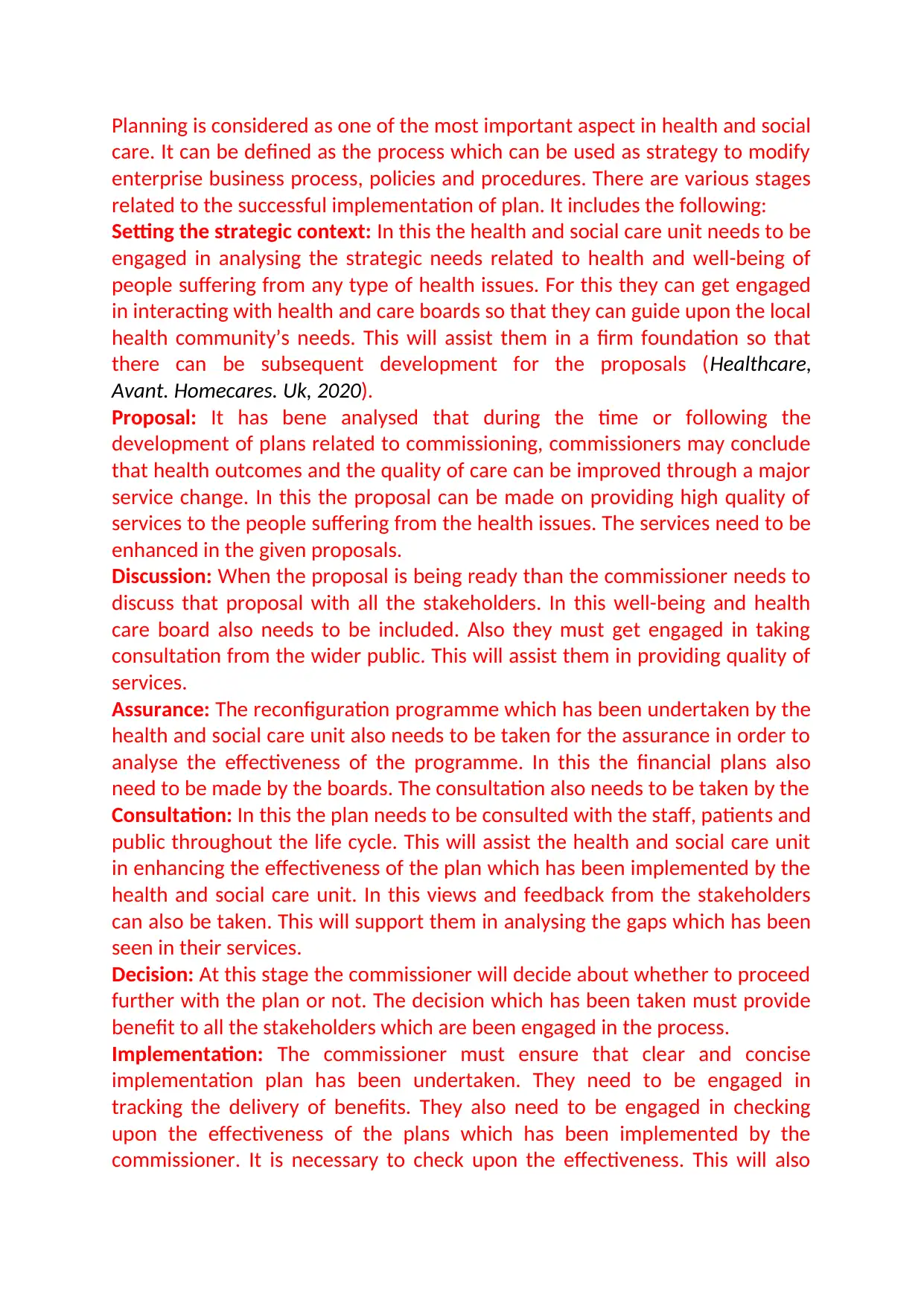
Planning is considered as one of the most important aspect in health and social
care. It can be defined as the process which can be used as strategy to modify
enterprise business process, policies and procedures. There are various stages
related to the successful implementation of plan. It includes the following:
Setting the strategic context: In this the health and social care unit needs to be
engaged in analysing the strategic needs related to health and well-being of
people suffering from any type of health issues. For this they can get engaged
in interacting with health and care boards so that they can guide upon the local
health community’s needs. This will assist them in a firm foundation so that
there can be subsequent development for the proposals (Healthcare,
Avant. Homecares. Uk, 2020).
Proposal: It has bene analysed that during the time or following the
development of plans related to commissioning, commissioners may conclude
that health outcomes and the quality of care can be improved through a major
service change. In this the proposal can be made on providing high quality of
services to the people suffering from the health issues. The services need to be
enhanced in the given proposals.
Discussion: When the proposal is being ready than the commissioner needs to
discuss that proposal with all the stakeholders. In this well-being and health
care board also needs to be included. Also they must get engaged in taking
consultation from the wider public. This will assist them in providing quality of
services.
Assurance: The reconfiguration programme which has been undertaken by the
health and social care unit also needs to be taken for the assurance in order to
analyse the effectiveness of the programme. In this the financial plans also
need to be made by the boards. The consultation also needs to be taken by the
Consultation: In this the plan needs to be consulted with the staff, patients and
public throughout the life cycle. This will assist the health and social care unit
in enhancing the effectiveness of the plan which has been implemented by the
health and social care unit. In this views and feedback from the stakeholders
can also be taken. This will support them in analysing the gaps which has been
seen in their services.
Decision: At this stage the commissioner will decide about whether to proceed
further with the plan or not. The decision which has been taken must provide
benefit to all the stakeholders which are been engaged in the process.
Implementation: The commissioner must ensure that clear and concise
implementation plan has been undertaken. They need to be engaged in
tracking the delivery of benefits. They also need to be engaged in checking
upon the effectiveness of the plans which has been implemented by the
commissioner. It is necessary to check upon the effectiveness. This will also
care. It can be defined as the process which can be used as strategy to modify
enterprise business process, policies and procedures. There are various stages
related to the successful implementation of plan. It includes the following:
Setting the strategic context: In this the health and social care unit needs to be
engaged in analysing the strategic needs related to health and well-being of
people suffering from any type of health issues. For this they can get engaged
in interacting with health and care boards so that they can guide upon the local
health community’s needs. This will assist them in a firm foundation so that
there can be subsequent development for the proposals (Healthcare,
Avant. Homecares. Uk, 2020).
Proposal: It has bene analysed that during the time or following the
development of plans related to commissioning, commissioners may conclude
that health outcomes and the quality of care can be improved through a major
service change. In this the proposal can be made on providing high quality of
services to the people suffering from the health issues. The services need to be
enhanced in the given proposals.
Discussion: When the proposal is being ready than the commissioner needs to
discuss that proposal with all the stakeholders. In this well-being and health
care board also needs to be included. Also they must get engaged in taking
consultation from the wider public. This will assist them in providing quality of
services.
Assurance: The reconfiguration programme which has been undertaken by the
health and social care unit also needs to be taken for the assurance in order to
analyse the effectiveness of the programme. In this the financial plans also
need to be made by the boards. The consultation also needs to be taken by the
Consultation: In this the plan needs to be consulted with the staff, patients and
public throughout the life cycle. This will assist the health and social care unit
in enhancing the effectiveness of the plan which has been implemented by the
health and social care unit. In this views and feedback from the stakeholders
can also be taken. This will support them in analysing the gaps which has been
seen in their services.
Decision: At this stage the commissioner will decide about whether to proceed
further with the plan or not. The decision which has been taken must provide
benefit to all the stakeholders which are been engaged in the process.
Implementation: The commissioner must ensure that clear and concise
implementation plan has been undertaken. They need to be engaged in
tracking the delivery of benefits. They also need to be engaged in checking
upon the effectiveness of the plans which has been implemented by the
commissioner. It is necessary to check upon the effectiveness. This will also
Paraphrase This Document
Need a fresh take? Get an instant paraphrase of this document with our AI Paraphraser
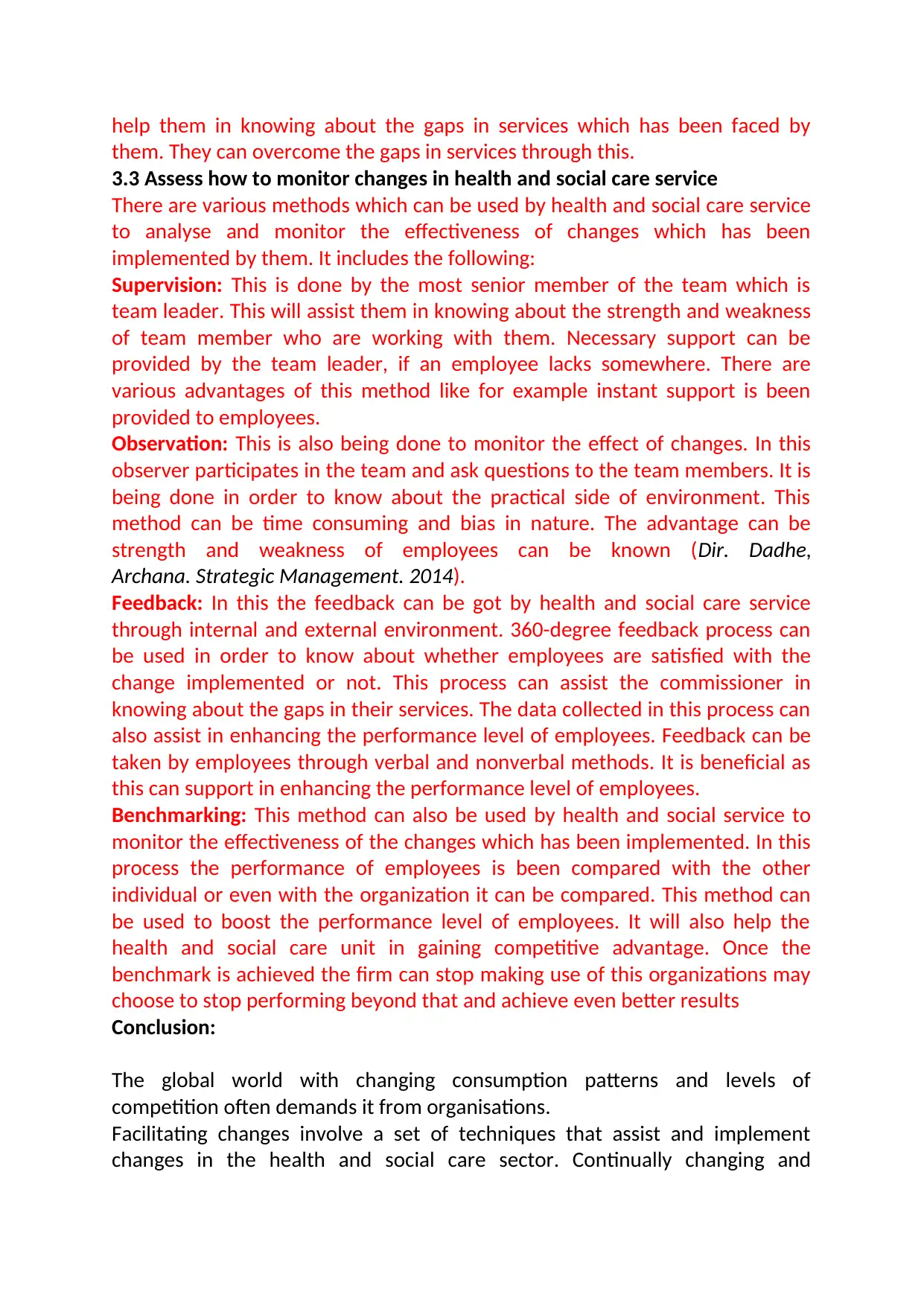
help them in knowing about the gaps in services which has been faced by
them. They can overcome the gaps in services through this.
3.3 Assess how to monitor changes in health and social care service
There are various methods which can be used by health and social care service
to analyse and monitor the effectiveness of changes which has been
implemented by them. It includes the following:
Supervision: This is done by the most senior member of the team which is
team leader. This will assist them in knowing about the strength and weakness
of team member who are working with them. Necessary support can be
provided by the team leader, if an employee lacks somewhere. There are
various advantages of this method like for example instant support is been
provided to employees.
Observation: This is also being done to monitor the effect of changes. In this
observer participates in the team and ask questions to the team members. It is
being done in order to know about the practical side of environment. This
method can be time consuming and bias in nature. The advantage can be
strength and weakness of employees can be known (Dir. Dadhe,
Archana. Strategic Management. 2014).
Feedback: In this the feedback can be got by health and social care service
through internal and external environment. 360-degree feedback process can
be used in order to know about whether employees are satisfied with the
change implemented or not. This process can assist the commissioner in
knowing about the gaps in their services. The data collected in this process can
also assist in enhancing the performance level of employees. Feedback can be
taken by employees through verbal and nonverbal methods. It is beneficial as
this can support in enhancing the performance level of employees.
Benchmarking: This method can also be used by health and social service to
monitor the effectiveness of the changes which has been implemented. In this
process the performance of employees is been compared with the other
individual or even with the organization it can be compared. This method can
be used to boost the performance level of employees. It will also help the
health and social care unit in gaining competitive advantage. Once the
benchmark is achieved the firm can stop making use of this organizations may
choose to stop performing beyond that and achieve even better results
Conclusion:
The global world with changing consumption patterns and levels of
competition often demands it from organisations.
Facilitating changes involve a set of techniques that assist and implement
changes in the health and social care sector. Continually changing and
them. They can overcome the gaps in services through this.
3.3 Assess how to monitor changes in health and social care service
There are various methods which can be used by health and social care service
to analyse and monitor the effectiveness of changes which has been
implemented by them. It includes the following:
Supervision: This is done by the most senior member of the team which is
team leader. This will assist them in knowing about the strength and weakness
of team member who are working with them. Necessary support can be
provided by the team leader, if an employee lacks somewhere. There are
various advantages of this method like for example instant support is been
provided to employees.
Observation: This is also being done to monitor the effect of changes. In this
observer participates in the team and ask questions to the team members. It is
being done in order to know about the practical side of environment. This
method can be time consuming and bias in nature. The advantage can be
strength and weakness of employees can be known (Dir. Dadhe,
Archana. Strategic Management. 2014).
Feedback: In this the feedback can be got by health and social care service
through internal and external environment. 360-degree feedback process can
be used in order to know about whether employees are satisfied with the
change implemented or not. This process can assist the commissioner in
knowing about the gaps in their services. The data collected in this process can
also assist in enhancing the performance level of employees. Feedback can be
taken by employees through verbal and nonverbal methods. It is beneficial as
this can support in enhancing the performance level of employees.
Benchmarking: This method can also be used by health and social service to
monitor the effectiveness of the changes which has been implemented. In this
process the performance of employees is been compared with the other
individual or even with the organization it can be compared. This method can
be used to boost the performance level of employees. It will also help the
health and social care unit in gaining competitive advantage. Once the
benchmark is achieved the firm can stop making use of this organizations may
choose to stop performing beyond that and achieve even better results
Conclusion:
The global world with changing consumption patterns and levels of
competition often demands it from organisations.
Facilitating changes involve a set of techniques that assist and implement
changes in the health and social care sector. Continually changing and
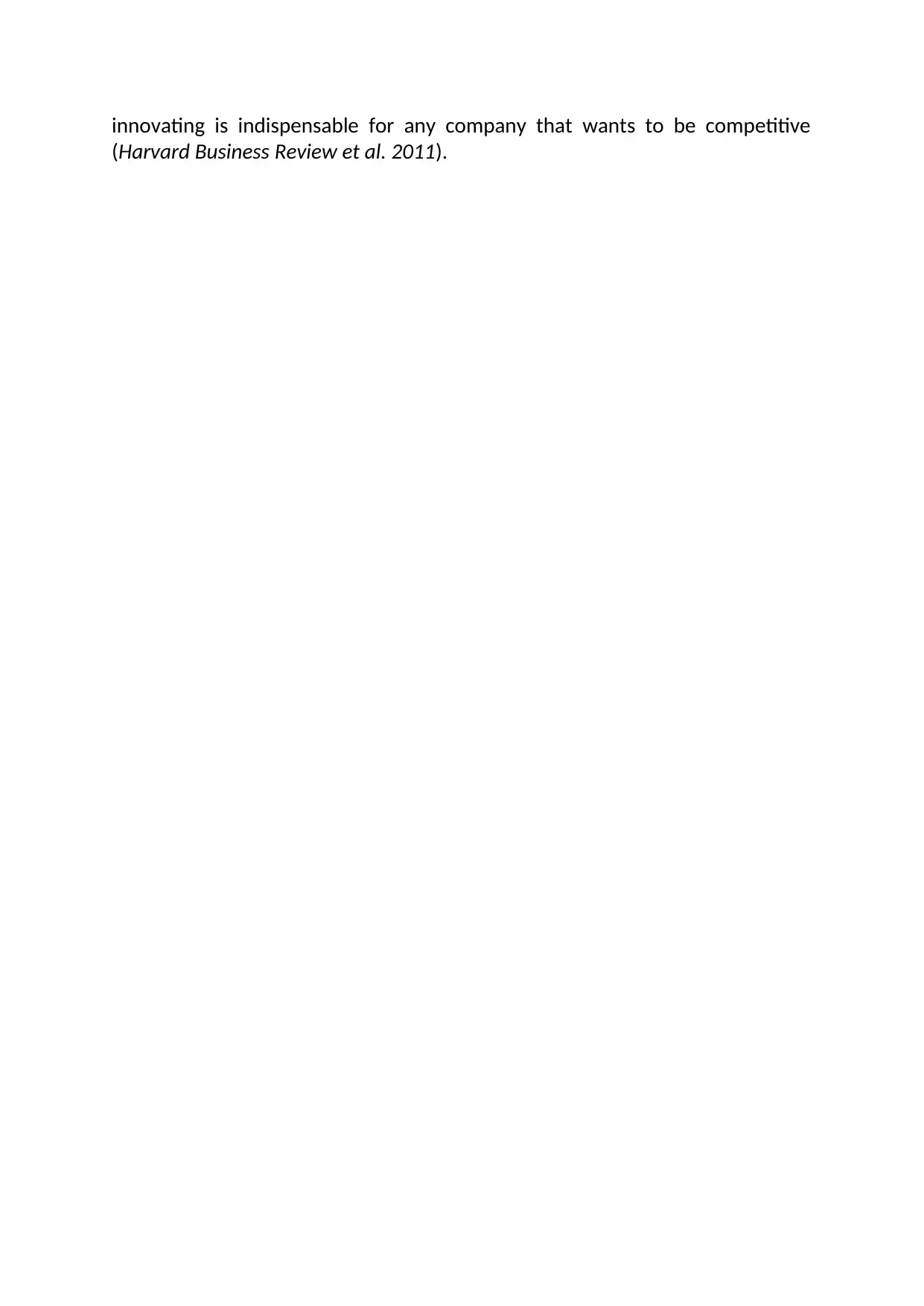
innovating is indispensable for any company that wants to be competitive
(Harvard Business Review et al. 2011).
(Harvard Business Review et al. 2011).
⊘ This is a preview!⊘
Do you want full access?
Subscribe today to unlock all pages.

Trusted by 1+ million students worldwide
1 out of 15
Related Documents
Your All-in-One AI-Powered Toolkit for Academic Success.
+13062052269
info@desklib.com
Available 24*7 on WhatsApp / Email
![[object Object]](/_next/static/media/star-bottom.7253800d.svg)
Unlock your academic potential
Copyright © 2020–2025 A2Z Services. All Rights Reserved. Developed and managed by ZUCOL.





